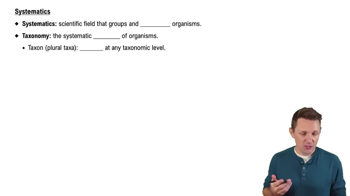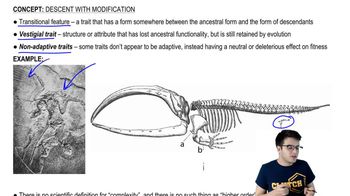Table of contents
- 1. Introduction to Biology2h 42m
- 2. Chemistry3h 40m
- 3. Water1h 26m
- 4. Biomolecules2h 23m
- 5. Cell Components2h 26m
- 6. The Membrane2h 31m
- 7. Energy and Metabolism2h 0m
- 8. Respiration2h 40m
- 9. Photosynthesis2h 49m
- 10. Cell Signaling59m
- 11. Cell Division2h 47m
- 12. Meiosis2h 0m
- 13. Mendelian Genetics4h 44m
- Introduction to Mendel's Experiments7m
- Genotype vs. Phenotype17m
- Punnett Squares13m
- Mendel's Experiments26m
- Mendel's Laws18m
- Monohybrid Crosses19m
- Test Crosses14m
- Dihybrid Crosses20m
- Punnett Square Probability26m
- Incomplete Dominance vs. Codominance20m
- Epistasis7m
- Non-Mendelian Genetics12m
- Pedigrees6m
- Autosomal Inheritance21m
- Sex-Linked Inheritance43m
- X-Inactivation9m
- 14. DNA Synthesis2h 27m
- 15. Gene Expression3h 20m
- 16. Regulation of Expression3h 31m
- Introduction to Regulation of Gene Expression13m
- Prokaryotic Gene Regulation via Operons27m
- The Lac Operon21m
- Glucose's Impact on Lac Operon25m
- The Trp Operon20m
- Review of the Lac Operon & Trp Operon11m
- Introduction to Eukaryotic Gene Regulation9m
- Eukaryotic Chromatin Modifications16m
- Eukaryotic Transcriptional Control22m
- Eukaryotic Post-Transcriptional Regulation28m
- Eukaryotic Post-Translational Regulation13m
- 17. Viruses37m
- 18. Biotechnology2h 58m
- 19. Genomics17m
- 20. Development1h 5m
- 21. Evolution3h 1m
- 22. Evolution of Populations3h 52m
- 23. Speciation1h 37m
- 24. History of Life on Earth2h 6m
- 25. Phylogeny2h 31m
- 26. Prokaryotes4h 59m
- 27. Protists1h 12m
- 28. Plants1h 22m
- 29. Fungi36m
- 30. Overview of Animals34m
- 31. Invertebrates1h 2m
- 32. Vertebrates50m
- 33. Plant Anatomy1h 3m
- 34. Vascular Plant Transport1h 2m
- 35. Soil37m
- 36. Plant Reproduction47m
- 37. Plant Sensation and Response1h 9m
- 38. Animal Form and Function1h 19m
- 39. Digestive System1h 10m
- 40. Circulatory System1h 57m
- 41. Immune System1h 12m
- 42. Osmoregulation and Excretion50m
- 43. Endocrine System1h 4m
- 44. Animal Reproduction1h 2m
- 45. Nervous System1h 55m
- 46. Sensory Systems46m
- 47. Muscle Systems23m
- 48. Ecology3h 11m
- Introduction to Ecology20m
- Biogeography14m
- Earth's Climate Patterns50m
- Introduction to Terrestrial Biomes10m
- Terrestrial Biomes: Near Equator13m
- Terrestrial Biomes: Temperate Regions10m
- Terrestrial Biomes: Northern Regions15m
- Introduction to Aquatic Biomes27m
- Freshwater Aquatic Biomes14m
- Marine Aquatic Biomes13m
- 49. Animal Behavior28m
- 50. Population Ecology3h 41m
- Introduction to Population Ecology28m
- Population Sampling Methods23m
- Life History12m
- Population Demography17m
- Factors Limiting Population Growth14m
- Introduction to Population Growth Models22m
- Linear Population Growth6m
- Exponential Population Growth29m
- Logistic Population Growth32m
- r/K Selection10m
- The Human Population22m
- 51. Community Ecology2h 46m
- Introduction to Community Ecology2m
- Introduction to Community Interactions9m
- Community Interactions: Competition (-/-)38m
- Community Interactions: Exploitation (+/-)23m
- Community Interactions: Mutualism (+/+) & Commensalism (+/0)9m
- Community Structure35m
- Community Dynamics26m
- Geographic Impact on Communities21m
- 52. Ecosystems2h 36m
- 53. Conservation Biology24m
21. Evolution
Introduction to Evolution and Natural Selection
Problem 8`
Textbook Question
Even though marsupial mammals give birth to live young, an eggshell forms briefly early in their development. This is evidence that:
a. Marsupials share a common ancestor with some egg-laying species
b. Marsupials are not really mammals
c. All animals arose from a common ancestor.
d. Marsupial mammals were separately created by God
e. The fossil record of marsupial mammals is incorrect
 Verified step by step guidance
Verified step by step guidance1
Step 1: Begin by analyzing the biological significance of the eggshell formation in marsupial mammals. The presence of an eggshell briefly during development suggests a connection to ancestral traits found in egg-laying species.
Step 2: Understand the concept of shared ancestry in evolutionary biology. Traits like eggshell formation can be considered vestigial, meaning they are remnants of features that were present in a common ancestor but have been reduced or modified in descendants.
Step 3: Evaluate the options provided in the question. Consider which option aligns with the evidence of shared traits and evolutionary relationships. For example, option (a) suggests a common ancestor with egg-laying species, which is consistent with evolutionary theory.
Step 4: Eliminate options that contradict established scientific principles. For instance, options (b), (d), and (e) are not supported by evolutionary biology or empirical evidence. Option (c) is overly broad and does not specifically address the eggshell formation in marsupials.
Step 5: Conclude that the most scientifically supported answer is option (a), as it aligns with the evidence of shared ancestry and evolutionary relationships between marsupials and egg-laying species.
 Verified video answer for a similar problem:
Verified video answer for a similar problem:This video solution was recommended by our tutors as helpful for the problem above
Video duration:
55sPlay a video:
Was this helpful?
Key Concepts
Here are the essential concepts you must grasp in order to answer the question correctly.
Common Ancestry
Common ancestry refers to the idea that different species share a common ancestor from which they evolved. This concept is fundamental in evolutionary biology, as it explains the similarities and differences among species. The presence of shared traits, such as the temporary formation of an eggshell in marsupials, supports the notion that marsupials and egg-laying species diverged from a common lineage.
Recommended video:

Common Misconceptions
Evolutionary Development
Evolutionary development, or evolutionary developmental biology (evo-devo), studies how developmental processes evolve and how they contribute to the diversity of life. The brief formation of an eggshell in marsupials indicates that certain developmental traits can be retained from ancestral species, even as organisms adapt to different reproductive strategies. This concept helps explain the evolutionary significance of developmental similarities.
Recommended video:

History of Evolutionary Theory Example 1
Mammalian Classification
Mammalian classification categorizes animals based on shared characteristics, such as mammary glands and live birth in most species. Marsupials, a subgroup of mammals, exhibit unique reproductive traits, including giving birth to underdeveloped young that continue to develop in a pouch. Understanding this classification is essential for recognizing the evolutionary relationships among different mammalian groups and their reproductive adaptations.
Recommended video:

Systematics

 4:58m
4:58mWatch next
Master Evolution and Natural Selection with a bite sized video explanation from Jason
Start learningRelated Videos
Related Practice
































